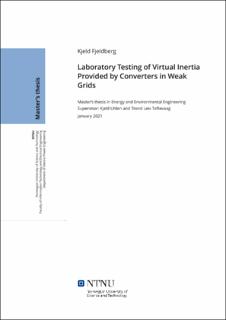| dc.contributor.advisor | Uhlen, Kjetil | |
| dc.contributor.advisor | Toftevaag, Trond Leiv | |
| dc.contributor.author | Fjeldberg, Kjeld | |
| dc.date.accessioned | 2021-09-15T17:19:20Z | |
| dc.date.available | 2021-09-15T17:19:20Z | |
| dc.date.issued | 2021 | |
| dc.identifier | no.ntnu:inspera:68534264:20828218 | |
| dc.identifier.uri | https://hdl.handle.net/11250/2778280 | |
| dc.description.abstract | Økende andel av uregelmessig fornybar energiproduksjon i nettet gir et økt behov for fleksibel energilagring for å sikre frekvensbalansen. Pumpekraftverk er den mest modne teknologien for å dekke dette behovet. Med variabel hastighet blir muligheten for å respondere til raske endringer i nettet forbedret. Når man kobler synkronmaskina fra nettet med kraftelektronikk blir frekvensene frikoblet og man mister det mekaniske treghetsmomentet til maskina. Hovedformålet med denne oppgaven er den økende interessen og behovet for virtuelt treghetsmoment.
Hensikten med denne oppgaven er å teste potensialet for å skape virtuelt treghetsmoment i et pumpekraftverk med variabel hastighet i et laboratoriumsforsøk. Laboratoriumsoppsettet har en 75 kVA synkronmaskin og en 45 kW DC-motor. Synkronmaskina skal representere et svakt nett, mens vannkraftverket er forenklet med en spenningskildeomformer som er forsynt av en DC-kilde. Et konvensjonelt PLL-synkronisert styresystem er valgt for omformeren. I tillegg til dette er det lagt til en supplementær kontrollsløyfe for å skape virtuelt treghetsmoment. Denne sløyfa består av en grein med droopregulering og en grein som gir et pådrag som er omvendt proporsjonalt med den deriverte av frekvensen (df/dt). En forenklet skisse over laboratoriumsoppsettet er vist i Figur 2.
Forsøket viste at kontrollsløyfa for treghetsemulering effektivt bidro med frekvensstøtte. Med både droop og df/dt regulering aktivert ble frekvensfallet redusert med 50 %, sammenliknet med den konvensjonelle omformerstyringen. For den konvensjonelle reguleringa var frekvensfallet 2,6 Hz, mens for reguleringssystemet med treghetsemulering ble frekvensfallet 1,3 Hz. Det var mulig å øke frekvensstøtten noe mer, men dette på bekostning av stabiliteten til systemet. Stabilitetsgrensene for det gitte systemet ble identifisert.
Et annet formål med denne oppgaven var å identifisere de elektriske standardparameterne for synkronmaskina brukt i forsøkene. Dette for fremtidige simuleringsstudier. Siden maskina var gammel ble det vurdert at den tradisjonelle kortslutningstesten kunne medføre skade på maskina. Det ble derfor utført lastavslagstester for å estimere verdiene. Testene som ble gjennomført var d-akse, q-akse og arbitrær akse lastavslagstest. Metninga av maskina ble ikke tatt hensyn til. Resultatene fra parameterestimeringa er vist i Tabell 2. En simuleringsmodell ble etablert for å kunne vurdere presisjonen for de estimerte parameterne. Det ble anslått at parameterne var innenfor de virkelige verdiene med noen få prosent. Verdi for lekkreaktansen ble ikke estimert, men man kan anta at denne verdien er 10 – 15 % av d-aksereaktansen. | |
| dc.description.abstract | Increasing penetration of intermittent renewable energy production raises the need for flexible energy storage to ensure the electric grid's frequency balance. Pumped hydropower is the most mature technology to meet this demand. With variable speed drive, the potential to respond to rapid fluctuations in the grid is improved. However, decoupling the synchronous machine from the grid with power electronics decouples the frequencies, and as a result, the inertia support of the machine is lost. This thesis's primary motivation is the increasing interest in and the need for artificial inertia in power systems.
This thesis aims to test the virtual inertia capabilities of a voltage source converter (VSC) connected variable speed hydropower plant (VSHP) in a laboratory experiment. The laboratory experiment has a generator/motor set consisting of a 75 kVA synchronous generator and 45 kW DC-motor. The synchronous machine will act as a single-machine equivalent of a weak grid while the hydropower plant is approximated with a VSC, supplied by a DC-source. A conventional PLL-synchronised control system regulates the converter with an added virtual inertia control loop. The method used to emulate virtual inertia consists of a regular droop control combined with a branch regulating on the derivative of the frequency (df/dt). A simplified sketch of the laboratory set-up is shown in Figure 1.
It is found that the inertia control loop effectively contributes with frequency support. When droop and df/dt control was added to the converter control, the frequency deviation was reduced with 50 % compared to the base case. The base case's frequency deviation was found to be 2.6 Hz while for df/dt inertia emulation (IE) the frequency deviation was found to be 1.3 Hz. It is possible to increase the frequency support further, but this comes at the cost of the stability of the system. The inertia support of the converter is constrained by stability limits of the converter and the rated power. The stability limits were identified in this thesis for the given system.
Another objective of this thesis was to identify the electrical parameters of the synchronous generator used in the set-up for future simulation studies. Due to the old age of the machine in question, it was deemed too hazardous to perform the traditional short circuit test. Three load shedding experiments were therefore performed to estimate the standard parameters, saturation effects were not considered. These tests were a d-axis, q-axis and an arbitrary axis load rejection test. The result from the estimation is presented in Table 1. A simulation model was established to evaluate the accuracy of the parameter estimation. The simulation results were promising, and it is deemed that the parameters were estimated with an accuracy of a few percentages. The leakage reactance was not estimated, but it can be assumed that this value lies in the range of 10 - 15 % of the d-axis reactance. | |
| dc.language | eng | |
| dc.publisher | NTNU | |
| dc.title | Laboratory Testing of Virtual Inertia Provided by Converters in Weak Grids | |
| dc.type | Master thesis | |
